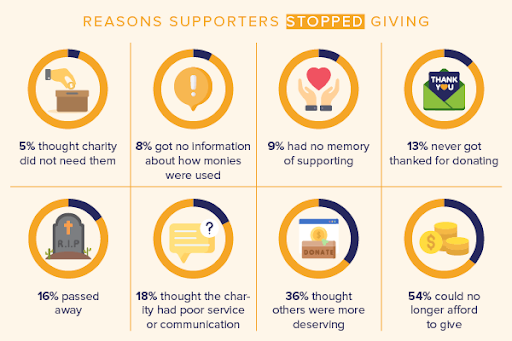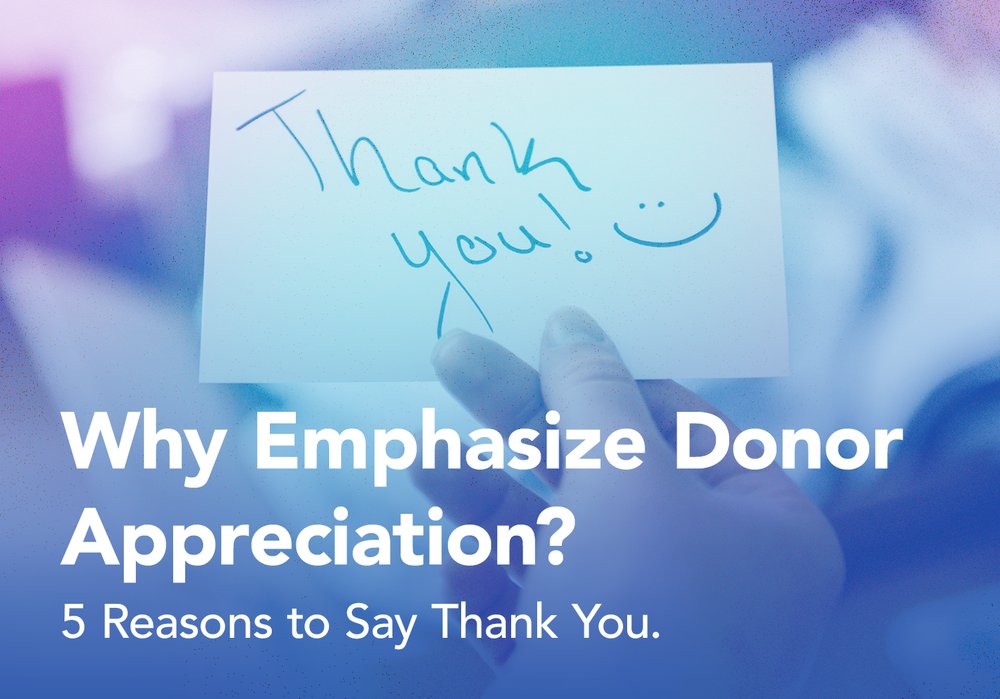Thank you: two little words that have the power to strengthen your donor community, foster a reliable giving stream, and improve your nonprofit’s reputation.
Your organization relies on donations to make your mission possible. Showing appreciation is not only polite but it also helps you raise additional funds and promote donor retention. The average donor retention rate for the nonprofit sector is just around 45%. A solid appreciation strategy will boost your organization’s retention to meet or exceed this standard.
According to a study conducted by academic Adrian Sargeant of the Institute for Sustainable Philanthropy, there are a few primary reasons why donors stop giving:

In this guide, we’ll explore ways to address these common causes of donor lapse and five reasons why you should develop an impactful donor appreciation strategy. To properly recognize your donors, you can:
- 1. Offer a gesture of goodwill.
- 2. Show donors that your nonprofit values them.
- 3. Remind supporters of their contributions.
- 4. Maintain ongoing communication with donors.
- 5. Demonstrate donors’ impact.
1. Offer a gesture of goodwill.
13% of supporters lapsed because they were never thanked for donating.
After receiving a gift, showing appreciation via a thank-you email is the least your nonprofit can do to show donors that you value their involvement and appreciate them as individuals. Your thank-you emails should:
- Be sent immediately after donors give
- Be personalized with donors’ names
- Reference donors’ specific gift amounts
Each donation is a new opportunity to show that you care about your supporters and appreciate their continued support, so make sure your organization sends automated thank-you emails immediately after a supporter gives.
2. Show donors that your nonprofit values them.
5% of donors lapsed because they thought the charity did not need them.
Your nonprofit wouldn’t be able to get started without donors’ valuable contributions. That means you need to show supporters just how important their gift is to the success of your organization.
Let donors know how much your nonprofit values their involvement by using your thank-you notes to:
- Highlight the specific positive impact that donors had on your mission. Connect donors’ gifts directly to your mission. For example, you might say something like “Thank you for contributing $50 to our Back-to-School campaign, where donors’ generous gifts funded school supplies for 100 students in our local community.”
- Ask for donors’ feedback. Allow donors to make their voices heard by sending them a short survey about the donation experience. Ask donors to provide input on the convenience of the giving process, the payment methods offered, and other aspects of your campaign.
- Provide multiple ways to get involved. Show donors that you value their continued support, whether through donations or other means. Invite supporters to engage in opportunities like peer-to-peer fundraising initiatives, volunteering, and advocacy.
When supporters contribute to a fundraising campaign, they do so because they feel a connection and emotional draw to the purpose of the campaign. Rarely do supporters give to organizations; they give to causes.
Welcome donors into your nonprofit community and provide them with opportunities to deepen their involvement with your cause. Donors will be much more likely to continue giving when they feel a personal connection to your nonprofit and your beneficiaries.
3. Remind supporters of their contributions.
9% of donors lapsed because they had no memory of supporting the organization.
If donors forget about your nonprofit, it shows that you did not make a lasting impression on them. To make an impression, your organization needs to maintain ongoing communication, reminding supporters about your cause and the campaign that drove them to contribute.
Take a multichannel outreach approach to connect with donors using unique touch points. Leveraging multiple platforms to reach out and say thank you increases the chances that supporters will see your message. These platforms may include:
- Email. Keep supporters in the loop with newsletter updates that spotlight your nonprofit’s other campaigns and programs.
- Social media. Encourage supporters to follow your organization on social media platforms, use your hashtags, and join your exclusive supporter Facebook group. Then, post updates about campaign progress and other important information.
- Phone calls. Make a quick phone call to express your gratitude and provide a more personal connection. This channel is especially well-suited to major donors and mid-level donors.
- Direct mail. Send letters to supporters to say thank you and update them on the campaign they supported. Make these messages even more personal by asking your executive director to sign them or recruiting volunteers to write the messages by hand.
Even if they don’t thoroughly read every email or social post you put out there, seeing your logo and messaging across a variety of platforms will help drive increased brand awareness for your cause and keep your nonprofit top-of-mind. This will remind supporters of their contribution and drive trust in your organization’s brand.
4. Maintain ongoing communication with donors.
18% of supporters lapsed because they thought the charity had poor service or communication.
It’s important to not only choose the right communication platforms but also to reach out at the right time and send tailored messages to each audience. Bloomerang’s donor management guide recommends segmenting donors based on characteristics they have in common. This allows you to develop more personalized messaging that speaks to the unique needs, interests, and motivations of different audiences.
Create a communication cadence for segments such as:
- First-time donors. New supporters are just getting to know your nonprofit and its mission. Focus your outreach efforts on sending introductory information, such as your nonprofit’s history or testimonials from community members you’ve supported.
- Recurring donors. Recurring donors, such as monthly donors, are more familiar with your organization and are already providing long-term support. These donors would benefit from ongoing impact updates and progress reports for your programs and initiatives.
- Major donors. Major donors provide your nonprofit with its largest gifts, so you should devote more time and attention to stewarding these supporters. Set up in-person meetings to thank them in a face-to-face setting and provide regular updates directly from your nonprofit’s executive director.
Use your nonprofit’s donor database to track donor data, such as their preferred communication platform, giving history, and engagement with volunteering. This information will help you personalize your communications, making them much more engaging for donors and improving your open and response rates.
Looking for ways to connect with donors?
Check out our list of 5 ways to engage donors with your marketing plan
5. Demonstrate donors’ impact.
8% of donors lapsed because they had no information about how the money was used.
36% of donors lapsed because they thought others were more deserving.
When supporters know that their contribution is going to a deserving recipient, they’ll get a warm, fuzzy feeling about the gift. However, if they’re unclear about how the money was used, that supporter could start to distrust your organization. They’ll be more likely to move to support a nonprofit where they know for certain that their gift makes a difference.
Provide clear evidence of the impact of your donors’ gifts by offering the following:
- An impact report. Provide each donor with a personalized annual data report with information about how much they contributed and how many beneficiaries they were able to help. Use eye-catching visual data representations, like bar charts or graphs, to give donors another way to visualize their impact.
- Community member testimonials. Send donors emails or blog posts highlighting testimonials from community members who have benefited from donations. Include photos and direct quotes to facilitate an emotional connection and empower donors to get to know the people they’re supporting.
- Recognition on your donor wall. Modern donor walls are so much more than just a list of names. If you have a digital donor wall, make sure you use it not just to highlight who gave money but also the impact their donation had.
- Personalized major donor presentation. Take your impact reports a step further for major donors by designing personalized presentations. Show major donors specifically how your nonprofit leveraged their gifts effectively to maximize its positive impact.
Additionally, outline how donors can have an even greater impact by increasing their giving amounts or becoming recurring supporters. For example, you might reach out to a donor who attended a silent auction event with a message that says “Thank you so much for your $100 contribution at our Winter Wonderland fundraising auction. Your gift helped fund school supplies for two local elementary school students. Did you know by turning your gift into a monthly recurring contribution, you can maximize your impact to help 24 students this year?”
Emphasizing donor appreciation is a strategic way to help your organization grow and recruit more long-term support for your mission. Going above and beyond in your donor appreciation sets your organization apart, showing supporters that you value them and that their gifts make a difference.




